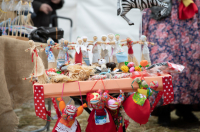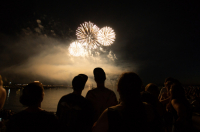Princess Olga of Kiev
This fierce and smart lady was instrumental in the course of Russian history. A pagan tribe called the Drevlyans killed her husband, Igor of Kiev, which made her the official ruler of Kievan Rus’ ( as in ancient Russia) until their three-year-old son Svyatoslav reached adulthood. Instead of succumbing to marriage proposals from the Drevlyan ruler, she revenged her husband’s death with basically obliterating the tribe, keeping its lands and taxing whoever was left on them. With rare political foresight, she also turned the powerful Byzantine empire into an allie by being the first Russian ruler to convert to Christianity. Her grandson Vladimir eventually converted the whole country.
Catherine The Great
German-born Empress of Russia, Catherine II led Russia into full participation in the political and cultural life of Europe, following the footsteps of her father Peter the Great. With her ministers she reorganized the administration and law of the Russian Empire and extended Russian territories. While a somewhat controversial figure in general methods and personal life, she undeniably was a moving force of her time.
Wives of Decembrists
If you live in St. Petersburg, you probably have been to the Decembrists’ Square, named after a tragic uprising on December 26, 1825. On that day, Russian army officers led several thousand soldiers in a protest against Tsar Nicholas I and were defeated by brutal force. Surviving rebels, dubbed Decembrists, were exiled to Serbia, and many of their wives followed them, despite the brutal journey and excruciating prospects of future life in spartan conditions. The expression The Decembrist Wife became a Russian symbol of the devotion of a wife to her husband.
Cosmonaut Valentina Tereshkova
In 1963, Valentina Tereshkova became the first woman in the world to travel into space. Inspired by first astronaut Yuri Gagarin, this woman of humble beginnings applied for the Soviet space program despite having no experience as a pilot. She lived well into her eighties, inspiring Soviet girls everywhere to know that the sky’s the limit.
Maya Plisetskaya
Probably the most famous Soviet and Russian ballerina, Maya Plisteskaya was an icon of virtuosity, beauty and dedication to her craft. The star of the Bolshoi Theater and Mariinsky Theater, as well as the top venues around the world, she inspired artists, fashion designers and musicians with her grace and sheer force of talent. Her performance of the dying swan in the Swan Lake is probably one ballet piece that is known to even non-ballet goers in Russia. I was lucky to see her in person when she was already in her late seventies, and she was still incredibly graceful, powerful and charismatic.
My Grandmothers
As a young girl, I watched my grandmothers change the world around them for the better in such different yet powerful ways, and even today, I often think about their courage and grace.
Natalia Borisovna Karachan was among the first to become a British Council student in the U.K., back in the 1950’s. During her year there she wrote a book about Lenin in London. For decades afterwards, she headed the Friendship Society between the Soviet Union and the U.K, engaging in the kind of citizen diplomacy that brought our worlds closer. She’s the sole reason I can speak English and my daily inspiration as an international journalist.
Irina Ivanovna Shevchenko was a primary school teacher who had infinite patience and affection for kids. As a child, she barely survived the battle of Stalingrad, yet till this day she remains the most optimistic person I know. Among other things, she taught me to wear lipstick and to never give up.




